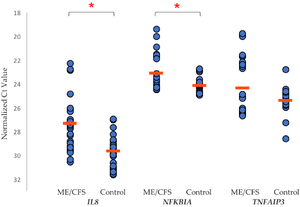Gene expression
From MEpedia, a crowd-sourced encyclopedia of ME and CFS science and history

The National Center for Biotechnology Information at the US National Institutes of Health (NIH) defines gene expression as "the phenotypic manifestation of a gene or genes by the processes of genetic transcription and genetic translation."[1] Gene expression takes place in two stages. The first is transcription: the base sequence on DNA is copied to a molecule of mRNA. Next, translation: the mRNA molecule leaves the cell nucleus for the cytoplasm and specifies the particular amino acids that will make up individual proteins in the process of protein synthesis.[1]
Gene expression analysis examines patterns of gene expression in transcription, whether under specific conditions or in certain kinds of cells.[1]
Notable studies[edit | edit source]
- 2009, A gene signature for post-infectious chronic fatigue syndrome[2]
Learn more[edit | edit source]
See also[edit | edit source]
References[edit | edit source]
- ↑ 1.0 1.1 1.2 "Gene Expression". ncbi.nlm.nih.gov. Retrieved January 31, 2019.
- ↑ Gow, John W; Hagan, Suzanne; Herzyk, Pawel; Cannon, Celia; Behan, Peter O; Chaudhuri, Abhijit (June 25, 2009). "A gene signature for post-infectious chronic fatigue syndrome". BMC Medical Genomics. 2: 38. doi:10.1186/1755-8794-2-38. ISSN 1755-8794. PMC 2716361. PMID 19555476.
This article is a stub. |

